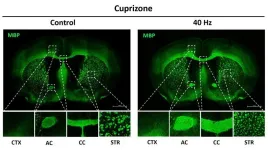(Press-News.org) A new UC Riverside study demonstrates that calorie restriction doesn’t deter mice from exercising, challenging the belief that dieting drains workout energy.
The study, published in the journal Physiology & Behavior, shows that cutting calories by 20% did not significantly reduce the distance that mice voluntarily chose to run each day.
The researchers set out to understand what happens to mice when the amount of food available to them is reduced. The findings, they hoped, would be relevant to wild animals that do not always get as much food as they want on a given day, and also to humans, whose doctors often prescribe dieting.
It is somewhat difficult to obtain accurate data on the amount of voluntary exercise that humans engage in. Though it is easy to categorize what people recognize as voluntary exercise, like a trip to the gym, there is much gray area that’s hard to quantify, such as walking to a cafeteria to purchase lunch instead of eating a meal from a nearby lunch box.
Tracking what lab mice choose to do is much easier, and lab mice generally like to run on wheels for many hours per day. In this study, researchers saw the mice chose to run at similar levels, regardless of how much they ate.
“Voluntary exercise was remarkably resistant to reducing the amount of food by 20% and even by 40%,” said UCR biologist and corresponding study author Theodore Garland, Jr. “They just kept running.”
The researchers spent three weeks getting a baseline level of running activity for the mice, then a week with calories reduced by 20%, and another week at minus 40%. This experiment was done both with regular mice as well as “high runner” mice bred to enjoy running.
Though the high runners reduced their total distance slightly with 40% calorie restriction, the distance was only an 11% reduction. As they started out running three times farther per day than normal mice, the reduction is considered slight. “They’re still running at extremely high levels,” Garland said. The regular mice did not reduce their daily distance, even at 40% calorie reduction.
Because running gives a “runners high,” in part by increasing dopamine and cannabinoid levels in the brain, the researchers believe the mice were motivated to keep going even with less food. “Wheel running is a self-rewarding behavior,” Garland said.
In addition, the researchers were surprised to find that body mass was not significantly affected by the 20% reduction in calories in either the regular or high-runner mice. Although there was some drop in body mass with a 40% reduction, it was not as high as predicted.
“People often lose about 4% of their body mass when they’re dieting. That’s in the same range as these mice,” Garland said.
This study contributes to our understanding of why some people like to exercise and others don't. In the future, the researchers are planning additional studies to understand why both the amount of voluntary exercise and body mass are so resistant to calorie restriction.
“There has to be some type of compensation going on if your food goes down by 40% and your weight doesn’t go down very much,” Garland said. “Maybe that’s reducing other types of activities, or becoming metabolically more efficient, which we didn’t yet measure.”
As habitat destruction causes food shortages for wild animals, this type of information could be instrumental for people trying to preserve species. And for the many people interested in improving their health, the implications could be similarly significant.
“We don’t want people on diets to say, ‘I don’t have enough energy, so I’ll make up for it by not exercising.’ That would be counterproductive, and now we know, it doesn’t have to be this way,” Garland said.
END
Cutting a few calories won’t hurt your workout
Dieting mice don’t skip exercise
2024-08-08
ELSE PRESS RELEASES FROM THIS DATE:
Study reveals ways in which 40Hz sensory stimulation may preserve brain’s ‘white matter’
2024-08-08
Early-stage trials in Alzheimer’s disease patients and studies in mouse models of the disease have suggested positive impacts on pathology and symptoms from exposure to light and sound presented at the “gamma” band frequency of 40 Hz. A new study zeroes in on how 40Hz sensory stimulation helps to sustain an essential process in which the signal-sending branches of neurons, called axons, are wrapped in a fatty insulation called myelin. Often called the brain’s “white matter,” myelin protects axons and insures better ...
Record-breaking recovery of rocks that originated in Earth’s mantle could reveal secrets of planet’s history
2024-08-08
Scientists have recovered the first long section of rocks that originated in the Earth’s mantle, the layer below the crust and the planet’s largest component.
The rocks will help unravel the mantle’s role in the origins of life on Earth, the volcanic activity generated when it melts, and how it drives the global cycles of important elements such as carbon and hydrogen, according to the team.
The nearly continuous 1,268 metres of mantle rock was recovered from a “tectonic window,” a section ...
Surprise: infected bacteria fight back with “hidden” genes that halt cell growth, slow viral spread
2024-08-08
Researchers have uncovered a surprising way bacteria defend themselves: when a bacterium is infected, bacterial enzymes that copy genetic information from RNA into DNA synthesize genes whose protein products help shut down cell growth. This prevents further viral spread in the neighboring bacterial population. The results highlight the potential for other “hidden” genes, like the one found here, to be unearthed in different biological contexts. Bacteria defend themselves from viral ...
Early prenatal exposure to famine increases Type 2 diabetes risk in adulthood, shows study of historical Ukraine event
2024-08-08
Prenatal exposure to famine significantly increases the risk of developing Type 2 diabetes mellitus (T2DM) in adulthood, according to a new study of people impacted by the 1932-1933 Holodomor famine in Ukraine. While the immediate and short-term effects of famines on mortality and morbidity are well-documented, deciphering famines’ long-term health consequences – as this study did – has been more difficult. Previous research has suggested a link between prenatal nutrition and adult health ...
Marine algae use massive enzymes of unprecedented size to biosynthesize fish-killing toxins
2024-08-08
Marine algae Prymnesium parvum use massive enzymes dubbed PKZILLAs – some of the largest proteins ever to be identified in nature – to make large and complex prymnesin neurotoxins responsible for mass fish kills during harmful algal blooms worldwide, researchers report. “The discovery and initial characterization of the prymnesin PKZILLA gigasynthases now elucidates the long-standing question about how microalgae biosynthesize their giant polyketide polyether molecules,” write the authors. It also expands ...
Record-breaking 1.2-kilometer drill core unveils new insights into Earth's mantle
2024-08-08
A record-breaking 1268-meter drill core into Earth’s mantle, collected from the Mid-Atlantic Ridge in the North Atlantic, has provided a deep and detailed mineralogical glimpse of the oceanic mantle. The findings reveal new insights into mantle composition, Earth’s deep geology, and the potential biogeochemical conditions involved in the origins of life. Understanding the Earth’s mantle is crucial for comprehending important details of the Earth system, including terrestrial magmatism, crust formation, and the cycling ...
American College of Cardiology issues guide for managing in-patient heart failure
2024-08-08
The American College of Cardiology has issued updated guidance on managing patients hospitalized for heart failure (HF) to provide a decision-making pathway that tailors therapy to clinical trajectory to better manage disease. The updated Expert Consensus Decision Pathway incorporates the latest evidence to provide guidance for clinicians to use at the point of care in conjunction with the 2022 ACC/AHA Heart Failure Guideline.
Heart failure refers to several conditions that can affect the way the heart works, its structure or both. Over time, heart failure makes ...
Type 2 diabetes cases more than doubled seven decades after exposure to famine
2024-08-08
Researchers at Columbia University Mailman School of Public Health, the University of North Carolina at Chapel Hill and at the National Academy of Sciences of Ukraine used the setting of the man-made Ukrainian Holodomor famine of 1932-1933 to examine the relation between prenatal famine and adult Type 2 diabetes mellitus (T2DM). They studied 128,225 Type 2 diabetes cases diagnosed between 2000-2008 among 10,186,016 male and female Ukrainians born between 1930 and 1938.
Individuals who were exposed in early gestation to the famine had a more than two-fold likelihood of developing Type 2 diabetes compared to those ...
Millions of years for plants to recover from global warming
2024-08-08
In brief:
Disruption of the functioning of vegetation due to warming can lead to the failure of climate regulating mechanisms for millions of years.
Vegetation changes can alter the planet’s climate equilibrium.
Geological and climatic history provide insight into the effects of global warming today.
Scientists often seek answers to humanity’s most pressing challenges in nature. When it comes to global warming, geological history offers a unique, long-term perspective. Earth’s geological ...
The long-lasting impact of war on global diabetes prevalence
2024-08-08
[Vienna, August 7 2024] — The ongoing war between Russia and Ukraine has led to severe humanitarian crises, including widespread food shortages. According to the United Nations World Food Programme, an estimated 11 million Ukrainians—about one-third of the population—were at risk of hunger in 2023. This crisis, exacerbated by supply chain disruptions and extreme weather events, could increase diabetes prevalence not only in Ukraine but globally, argue Peter Klimek and Stefan Thurner from the Complexity Science Hub in a commentary published in the journal Science.
Malnutrition during early pregnancy is known to elevate diabetes ...
LAST 30 PRESS RELEASES:
A new way to map how cells choose their fate
Numbers in our sights affect how we perceive space
SIMJ announces global collaborative book project in commemoration of its 75th anniversary
Air pollution exposure and birth weight
Obstructive sleep apnea risk and mental health conditions among older adults
How talking slows eye movements behind the wheel
The Ceramic Society of Japan’s Oxoate Ceramics Research Association launches new international book project
Heart-brain connection: international study reveals the role of the vagus nerve in keeping the heart young
Researchers identify Rb1 as a predictive biomarker for a new therapeutic strategy in some breast cancers
Survey reveals ethical gaps slowing AI adoption in pediatric surgery
Stimulant ADHD medications work differently than thought
AI overestimates how smart people are, according to HSE economists
HSE researchers create genome-wide map of quadruplexes
Scientists boost cell "powerhouses" to burn more calories
Automatic label checking: The missing step in making reliable medical AI
Low daily alcohol intake linked to 50% heightened mouth cancer risk in India
American Meteorological Society announces Rick Spinrad as 2026 President-Elect
Biomass-based carbon capture spotlighted in newly released global climate webinar recording
Illuminating invisible nano pollutants: advanced bioimaging tracks the full journey of emerging nanoscale contaminants in living systems
How does age affect recovery from spinal cord injury?
Novel AI tool offers prognosis for patients with head and neck cancer
Fathers’ microplastic exposure tied to their children’s metabolic problems
Research validates laboratory model for studying high-grade serous ovarian cancer
SIR 2026 delivers transformative breakthroughs in minimally invasive medicine to improve patient care
Stem Cell Reports most downloaded papers of 2025 highlight the breadth and impact of stem cell research
Oxford-led study estimates NHS spends around 3% of its primary and secondary care budget on the health impacts of heat and cold in England
A researcher’s long quest leads to a smart composite breakthrough
Urban wild bees act as “microbial sensors” of city health.
New study finds where you live affects recovery after a hip fracture
Forecasting the impact of fully automated vehicle adoption on US road traffic injuries
[Press-News.org] Cutting a few calories won’t hurt your workoutDieting mice don’t skip exercise




